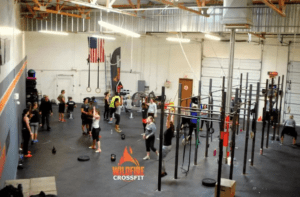CrossFit has been getting a bad rap for as long as I can remember. Everybody knows somebody, who knows somebody else, who got injured doing CrossFit. As of late, I’ve noticed that start to turn around, but I still hear the occasional groan from across the room when someone mentions being a CrossFitter.
But is CrossFit really to blame for injury, or do we just talk about it a lot? To answer that, let’s discuss the following:
- The truth about injury rates in CrossFit
- What you can do to both improve performance and reduce risk of injury
The truth about injury rates in CrossFit
Because CrossFit is relatively new and the process of running and publishing studies takes several years, the research on injury rates is not robust. However, the studies that do exist give us some useful insight. Check out these results from studies comparing injury rates in CrossFit to other sports:
Study 1: 2014
- CrossFit injury incidence: 19.4% over 6 months
- Long distance running injury incidence: 19.4-79.3% over 6 months
Conclusion: You have the same or higher chance of getting injured by doing long distance running, than by doing CrossFit.
Study 2: 2013
- CrossFit injury rate: 3.1/1000 h (hours of training)
- Olympic lifting injury rate: 3.3/1000 h
- Gymnastics injury rate: 3.1/1000 h
- American high school football injury rate: 140/1000 h
- Ice hockey injury rate: 78.4/1000 h
Study 3: 2018
- CrossFit injury rate: 0.27-0.74/1000 h
Conclusion: Don’t play high school football if you want to stay injury-free. All kidding aside, injury rates are very similar to that of other weight-lifting routines – specifically Olympic lifting and gymnastics.
One limitation of these studies is that none are the type considered the highest of quality. More research would likely be beneficial in confirming these findings.
What you can do to reduce your risk of injury
One of the studies mentioned above also happened to look at injury rates based on coach involvement. Not surprisingly, increased involvement of CrossFit coaches directly correlated to decreased injury rates.
What does this mean? Find yourself a box with coaches who pay attention! Their guidance, corrections and modifications are extremely beneficial in keeping you healthy. Not every box or gym is created equal – there can be a large variation in the experience and expertise of the owners and coaches. So if you’re considering trying CrossFit, test out a few different ones in your area and find one where you feel comfortable and safe.
As a self-proclaimed gym hopper (I’m not proud of it, but I have high standards), I’ve experienced 3 different CrossFit gyms in the Phoenix area. I can confidently say that Wildfire CrossFit is a box with an exceptional team that prioritizes proper mechanics and technique before lifting wild (pun intended) amounts of weight.
In addition to finding the right box, be smart about your past injuries as well as current aches and pains. Let your coach know if you need to make any modifications. Show up on time or early to ensure a proper warm-up. And finally, listen to your body (easier said than done, I know) – it is ok to slow down your workout or lighten up on weights when you’re feeling run down.
A thorough physical therapy evaluation can optimize your movement patterns to enhance performance – contrary to popular belief, you don’t have to be injured to come see us at DPT! If you’re looking to improve performance while preventing injury, give us a call today.
In addition, realistically, injuries do happen – oftentimes due to underlying strength, mobility or stability deficits. If this is your current situation, we at DPT would love to help you out. We work with athletes of all levels to get them back to the activities they love, stronger and more resilient than ever before.
References
1. Weisenthal, B. M., Beck, C. A., Maloney, M. D., DeHaven, K. E., & Giordano, B. D. (2014). Injury rate and patterns among CrossFit athletes. Orthopaedic Journal of Sports Medicine, 2(4), 2325967114531177.
2. Hak, P. T., Hodzovic, E., & Hickey, B. (2013). The nature and prevalence of injury during CrossFit training. Journal of strength and conditioning research.
3. Feito, Y., Burrows, E. K., & Tabb, L. P. (2018). A 4-Year Analysis of the Incidence of Injuries Among CrossFit-Trained Participants. Orthopaedic Journal of Sports Medicine, 6(10), 2325967118803100.
4. Klimek, C., Ashbeck, C., Brook, A. J., & Durall, C. (2018). Are injuries more common with crossfit training than other forms of exercise?. Journal of sport rehabilitation, 27(3), 295-299.
Blog image: https://www.self.com/story/female-crossfit-stars-to-follow-on-instagram







